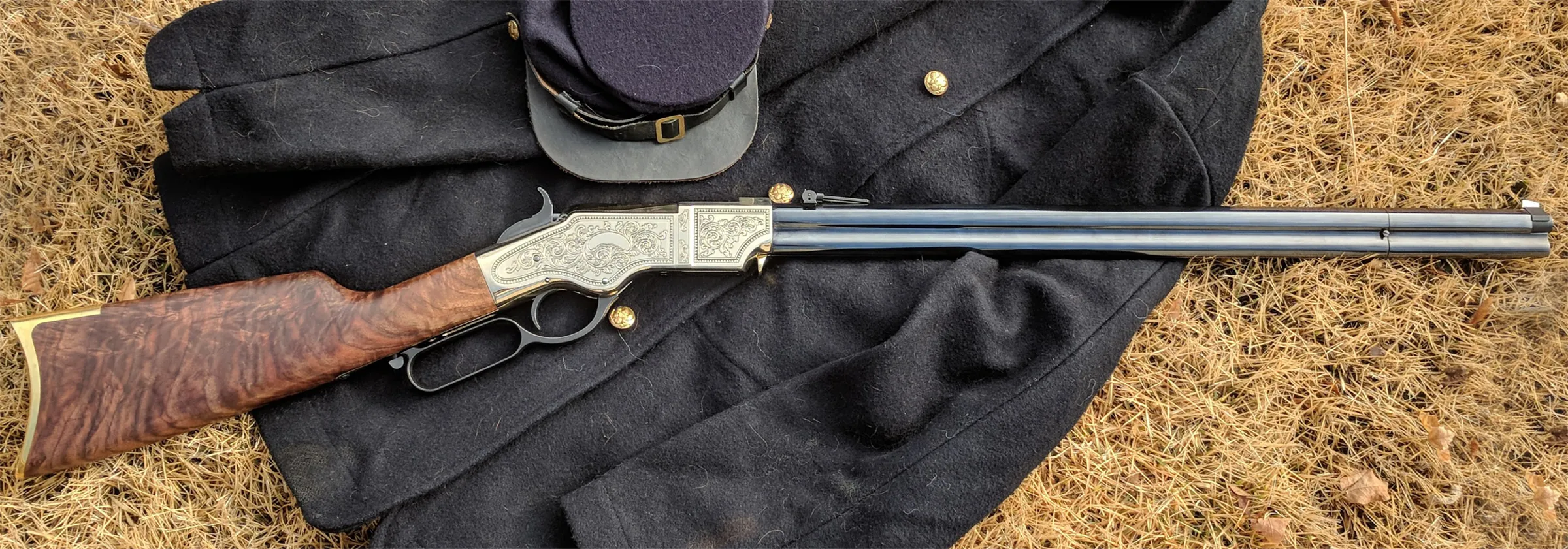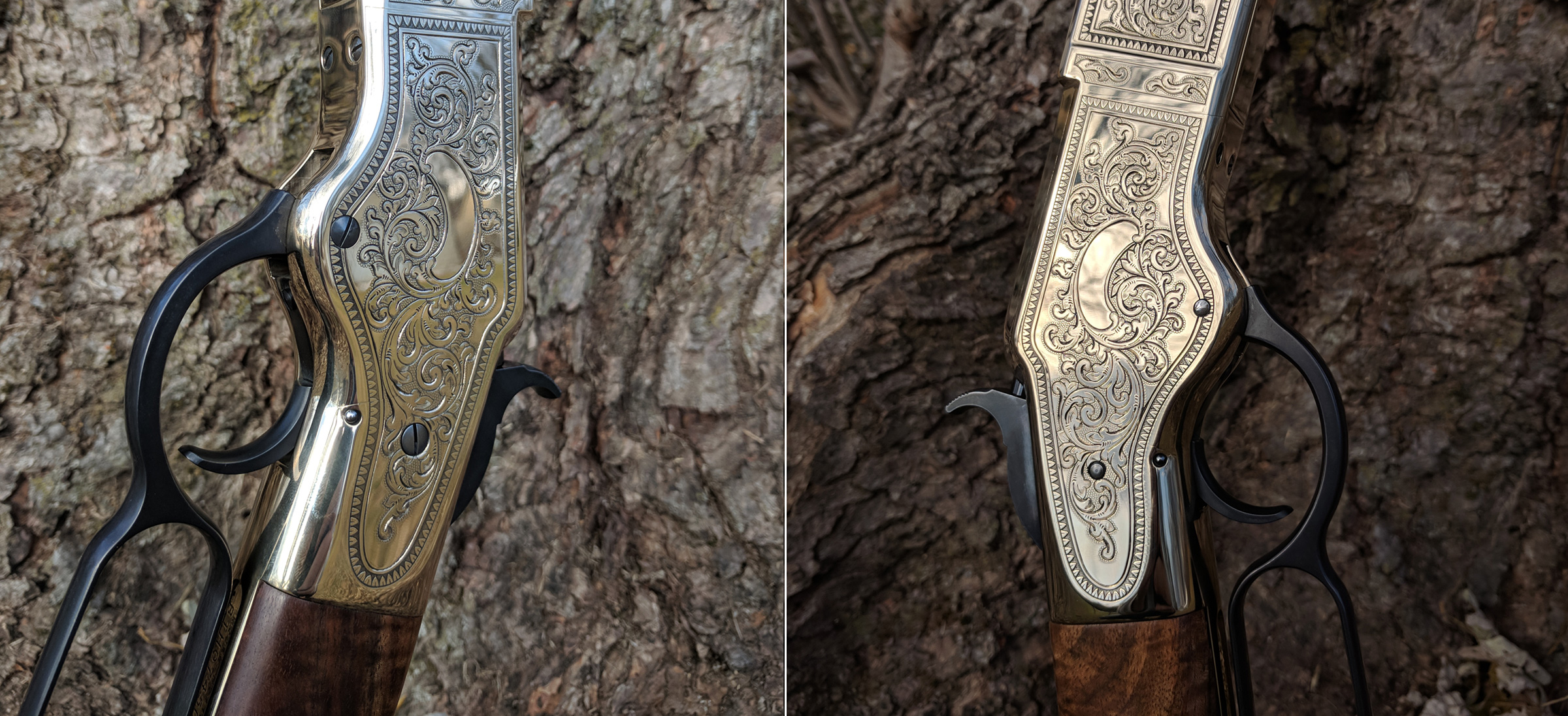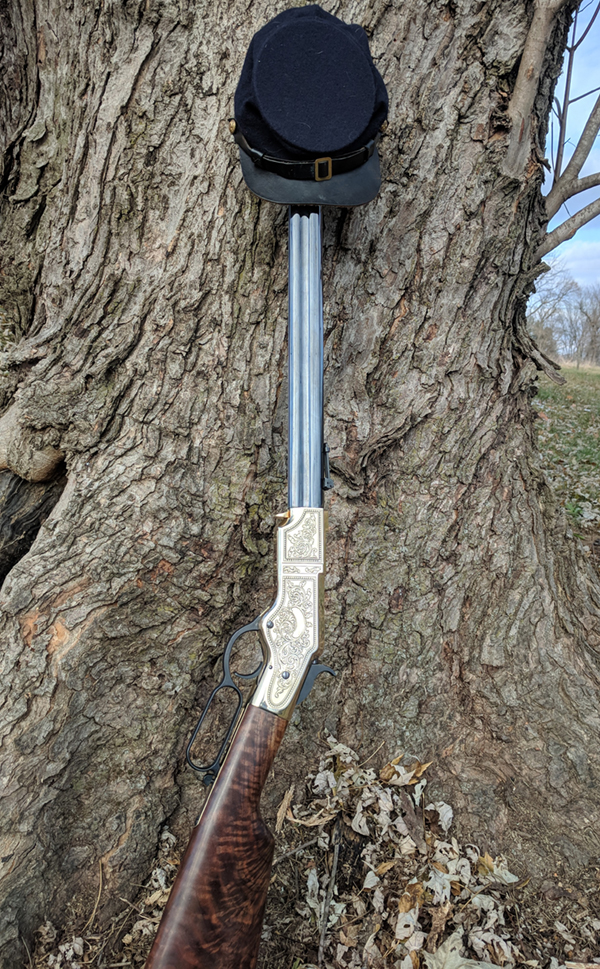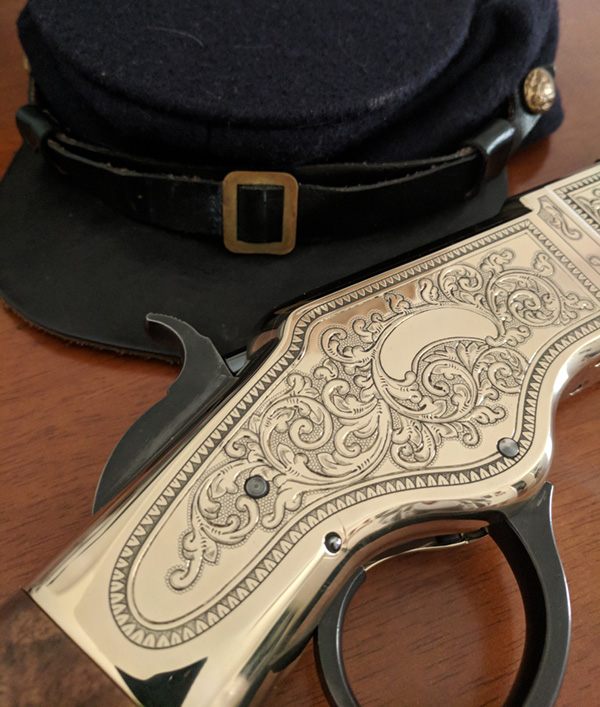An Instant Heirloom
Henry Original Deluxe Engraved Rifle

Original, engraved Henry Model 1860 rifles are examples of exquisite craftsmanship. Not surprisingly, this makes them hard to come by. Oftentimes, they were often reserved for important people: President Abraham Lincoln, Secretaries of War Simon Cameron and Edwin Stanton, and Secretary of the Navy Gideon Welles were all presented Henry rifles. (Interestingly, Lincoln and Welles received serial numbers 6 and 9, respectively. Cameron received serial number 119. Stanton received the coveted serial number 1.)
Inventor Benjamin Tyler Henry spared no expense on the rifles he presented to the four men listed above. Hand engraved and plated in gold or silver, they were fitted with fancy wood stocks made of black walnut, rosewood, or a premium selection of American walnut.
In 1862, a standard Henry rifle cost $42.00. Because they were significantly more expensive than their muzzleloading counterparts, fewer than 2,000 of the total production run of 14,000 rifles were purchased by the United States Government. Since the average Union soldier was paid just $13.00 per month, seeing an entire unit armed with Henry rifles was exceptionally rare, though it did happen. The 7th Illinois Volunteer Infantry purchased more than 500 rifles at a cost of $52.50 each, and the 66th Illinois Volunteer Infantry purchased more than 220 rifles. Adhering to supply-and-demand economics, the cost of Henry rifles being purchased for soldiers ranged from as low as $36.00 to as high as $80.00, depending on when and where the rifles were purchased.
Historic records indicate that at least 38 Union regiments were armed in part with Henry rifles, along with a total of eight naval vessels. There were also 15 Confederate regiments reported to have had some men fielding the Henry Model 1860 rifle.

New Haven Arms Company offered the Henry with some extra options. Silver plating and engraving cost an additional $10.00; gold plating and engraving cost an additional $13.00. All told, a gold plated and engraved Henry rifle cost $55.00 – or more than four months’ pay for the average soldier. Adjusted for inflation, that elaborate rifle would cost $1,350.00 today. This price would be a steal for collectors, as they routinely sell for tens of thousands of dollars at auction today.
When asking someone to spend a significant amount of money for a product, you want to be sure that it is of the highest quality possible. For Henry, this meant employing an engraver of the highest skill level. Mr. Henry’s engraver of choice was Samuel James Hoggson. Born in November 1828 in Glasgow, Scotland, he came to New Haven, Connecticut, as a young man and married Lucy MacLean. Their son, William John, was born in 1861 and continued his father’s engraving trade in nearby Bridgeport. Samuel lived to the age of 82 and died in March 1911. Beyond this, little is known of Samuel James Hoggson. Even the spelling of his name was up for debate for some time – Hoggson, Hoggeson, Hogson, Hodgson, etc.
 Engravers tend to specialize in certain styles of artwork. Some like scrolls; others prefer patterns. Hoggson, however, often used vines and flowers depicted against a stippled background. That design is considered to be his signature style. Animals, such as dogs and deer, sometimes appeared in his work as well.
Engravers tend to specialize in certain styles of artwork. Some like scrolls; others prefer patterns. Hoggson, however, often used vines and flowers depicted against a stippled background. That design is considered to be his signature style. Animals, such as dogs and deer, sometimes appeared in his work as well.
Made in 1862, Henry rifle serial number 18 is believed to have been engraved by Samuel Hoggson. It is that particular rifle’s engraving which today’s Henry Repeating Arms, along with engraving company Baron Technologies, has chosen to recreate on their newest limited run of deluxe engraved Henry Original rifles.
“Engraving has traditionally been reserved for very special guns, a way to set a highly prized personal possession or gift aside from the everyday pack. All the way from highly ornate and unique presentation pieces, through standardized patterns, to merely a name and a date; artistic engraving can add beauty to any gun, along with value and heirloom historicity.” That is how Henry Repeating Arms describes the second run of their deluxe engraved Henry Original rifles. It’s clear that they understand the importance an engraved gun can have to its owner.
Baron’s master engraver Rob Bunting, with background and artistic help from engraver Seth Karlak and artist Catarina Pech, have faithfully executed a nod to inventor Benjamin Tyler Henry and engraver Samuel Hoggson. The pattern from serial number 18 is duplicated on both sides of the brass frame, and it is actually cut, not molded, and hand chased for a superb finish.
Fitted with a fancy American walnut stock, the limited run of 1,000 rifles each sport a unique serial number, ranging from BTH0001D2 to BTH1000D2. (BTH for Benjamin Tyler Henry; D for Deluxe; 2 for the second run.)
The end result is a rifle that is regarded by many as a work of art, but is also a fully-functioning firearm. After all, if you’re trying to impress some important person with your product (like the President of the United States), you want to be sure that the example they receive both looks and performs great. Mr. Henry achieved this balance with the rifle he gave to President Lincoln; Mr. Imperato also achieved this balance with this limited run of deluxe engraved Henry Original rifles.
The fit and finish on these rifles is exceptional. Everyone I showed the rifle to has marveled at how beautiful it is. The bluing is deep and lustrous; the grain in the stock is remarkable, and the engraving on the receiver is top-notch. Many gasped when I told them I intended on firing the rifle. Looking good is nice, but proper functioning is essential.
My first range trip with the rifle was exciting. Having never fired an original Model 1860 or a Henry Original, I was curious to see how the mechanics of the design worked. More than 150 years later, Benjamin Tyler Henry’s creation stands the test of time. While the original Henry Model 1860 fired the .44 Henry rimfire cartridge, today’s Henry Original has been slightly modified to fire the more readily-available (and more powerful) .44-40 centerfire cartridge. The .44 Henry cartridge consisted of a 200-grain projectile on top of 26-28 grains of blackpowder. The .44-40 loads I used had the same projectile weight, but were loaded with 40 grains of smokeless powder.
 One report from 1863 claimed that the Model 1860 was capable of providing “certain death at 800 yards and probably 1,000 yards.” (Obviously, lofty marketing claims haven’t changed in the past century and a half.)
One report from 1863 claimed that the Model 1860 was capable of providing “certain death at 800 yards and probably 1,000 yards.” (Obviously, lofty marketing claims haven’t changed in the past century and a half.)
Sighted at 100 yards, a modern .44-40 load will have a drop of almost 30 inches at 200 yards. Factoring in the shortcomings of the .44 Henry, it’s unlikely that shots at 200 yards would be effective from that cartridge.
Regardless, the true selling point of the Model 1860 wasn’t so much its range as it was its magazine capacity. The tubular magazine located under the barrel held 15 cartridges, enabling the shooter to fire 15 rounds just as fast as they could work the action. In an era of single-shot muzzleloaders capable of firing three rounds per minute at best, it’s no wonder that the Henry became known as the rifle you “load on Sunday and shoot all week long.”
Today’s Henry Original holds 13 rounds because the .44-40 is slightly larger than the .44 Henry, but it functions the same way as its predecessor. Loading is accomplished by raising the follower to the muzzle end of the magazine and pivoting it sideways to provide access to the tube. Once the cartridges are loaded, the end of the magazine is rotated back into place and the follower rests on the nose of the last round. With each cycling of the action, a spent cartridge is ejected from the top of the receiver and a new one is elevated from below into the barrel. With each shot, the spring-loaded follower moves toward the receiver, keeping tension on the rounds in the magazine.
I had the opportunity to shoot the Henry Original rifle out to 100 yards. At that distance, I was able to achieve groups between six and eight inches in diameter. That’s not bad considering the historic limitations of both the rifle and the cartridge. It’s well within a man-sized target and is enough to make me concerned if I were at that distance (or closer) to a group of people armed with Henry rifles.
The Henry Original is a solid rifle. At 43” long, it has a 24.5” barrel. Combined with the heft of its brass receiver, the rifle weighs in at more than nine pounds when fully loaded. Recoil is minimal and follow-up shots are easy once you get into the rhythm of working the action. This makes the gun an absolute joy to shoot.
If you’re a fan of historic rifles but can’t afford one that is 150+ years old, I’d highly recommend taking Henry Repeating Arms’ advice: invest in an American legend. This deluxe engraved Henry Original would look right at home next to President Lincoln’s rifle at the Smithsonian. While yours isn’t likely to end up in a museum, it’s sure to make the eyes of your friends and family light up when they see it – and they’ll be glad it’s not in a museum so that they can truly appreciate the heirloom-quality craftsmanship firsthand, without the glass and guards!
Logan Metesh is a firearms historian, writer, and museum professional who runs High Caliber History LLC. He has spent more than a decade working for the NRA Museums, the Smithsonian Institution, and the National Park Service. He has been a frequent guest on NRATV’s Curator’s Corner and has served as an historic firearms facilitator for television shows such as Mysteries at the Museum, Gun Stories with Joe Mantegna, NRA Gun Gurus, and American Rifleman TV.
REVIEWS
Henry Repeating Arms big boy Steel .44 Magnum Review- by Eve Flanigan
Henry Color Case Hardened Edition Rifle in .45-70 Goverment- By Jon Wayne Taylor






